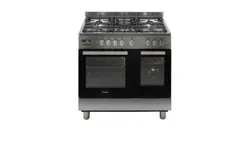Loading ...
Loading ...
Loading ...

GB - 12
5
SWITCHING THE HEATING ELEMENTS
The cooking zones are clearly visible on the hob,
being circular. Only the inside of the circles traced on
the glass is heated.
The hob has a built-in warning light that switches on
when the temperature in the cooking zone exceeds
60°C. This warning light will only switch off when the
temperature in the cooking zone has gone below this
value and it is for this reason it is called the “residual
heat warning”.
The heating elements with a single ccoking zone,
are controlled by energy regulators with 12 positions
(A) that permit to obtain a big range of different
temperatures.
The heating element with a double cooking zone, are
controlled by 12-position energy regulators (B).
By turning the knob from 1 to 12, the powers of the rst
zone of cooking “1” are regulated. By turning besides
the number 12, a release it is warned that signals the
insertion of the second zone of cooking “2” (g. 5).
In this position, both work the zone of cooking to the
maximum power. By turning the knob counterclockwise
to regulate its power.
Only returning on the position “0” the second zone of
cooking is disconnected.
A red coloured warning light signals that the heating
elements are on.
GENERAL INFORMATION AND INSTRUCTIONS
FOR USING CERAMIC GLASS HOBS
• Ceramic glass is a natural product and, like any
other material in ceramic, can have an uneven
surface. You might even see some bubbles inside
the ceramic glass itself: these will not inuence
cooking or the lifetime of the hob.
• Illumination of the single cooking zones might differ.
This depends on the technical characteristics of the
heating elements. This has absolutely no effect on
quality or operation.
• According to how you look at it, the incandescent
heating might appear to go over the edge of the
cooking zone.
• Do not put very hot pans on the outer edge of the
hob.
• Do not use pans with aluminum bottom.
• Do not use the hob as a work top and take care not
to let hard or sharp objects fall on it. The top could
be damaged.
• Do not put empty enamelled pans on the heat. Both
the bottom of the pan and the ceramic glass could
be damaged.
• Do not drag pans or other objects over the glass top
which could get scratched.
• Clean and dry the bottom of the pan before putting
it on the hob. Salt, sugar or grains of sand, for
example, that could be in greens, can scratch.
• Clean off immediately any spilled liquid.
• Do not cook or reheat food wrapped in tin foil or
plastic containers. Both the tin foil and the plastic
containers would melt, sticking to the hob.
N.B.: Using the glass scraper, push immediately
away from the cooking zone, any pieces of tin foil
or plastic objects that could have melted or stuck;
likewise sugar or sugary food spilled over during
cooking.
INSTRUCTIONS FOR THE USER
Loading ...
Loading ...
Loading ...
